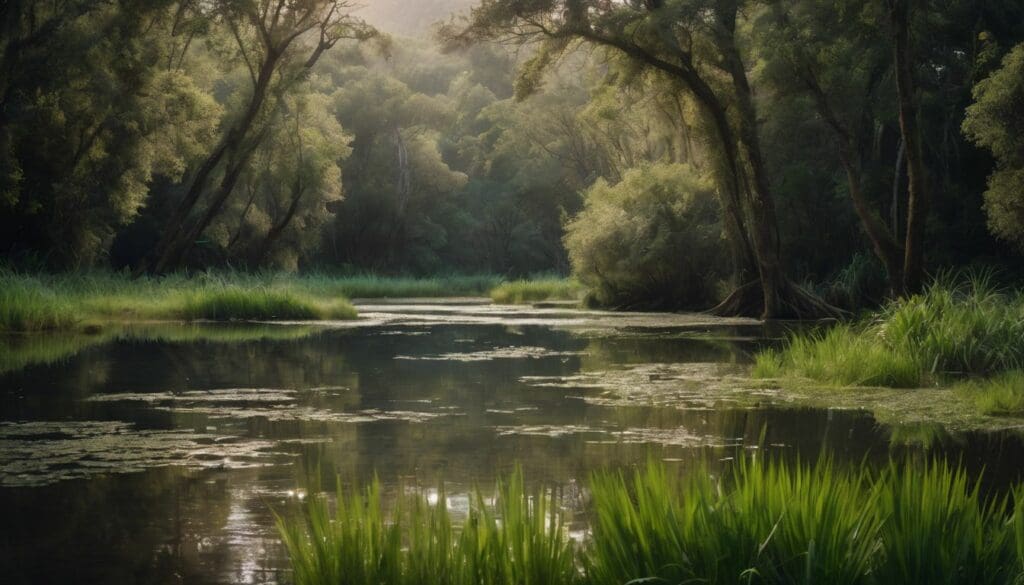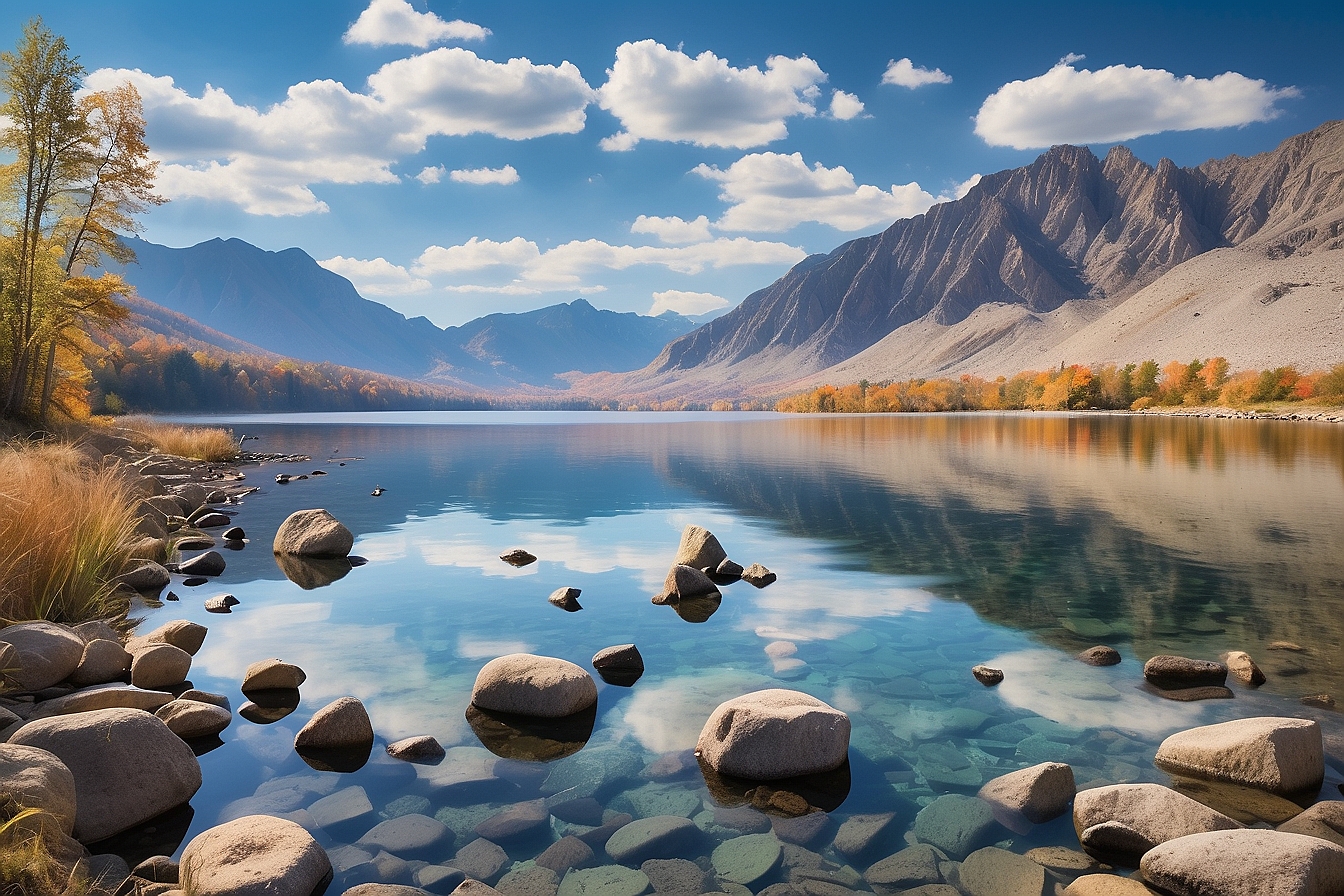Flooding is increasingly at the forefront of our minds, with climate change and erratic weather patterns frequently dominating the news. Perhaps like many others, you’ve witnessed first-hand the devastating effects that floods can have on communities, landscapes and livelihoods.
It’s a shared concern we all hold close to our hearts as we look for dependable solutions to combat this natural crisis.
In seeking out such answers, we’ve stumbled upon an understanding that has been quietly underappreciated – the remarkable ability of wetlands to stem the tide of floodwaters. These natural basins possess a near-miraculous capacity to dampen flood impacts, with studies showing they can lower flood levels by up to 60%.
Our forthcoming article delves into these havens; examining how these ecological marvels meticulously safeguard both our homes and cherished wildlife from Nature’s more tempestuous moods.
Join us as we explore how wetlands serve not only as wildlife sanctuaries but also form a core part of nature’s own flood defence mechanism – an insightful journey into recognising and celebrating one of Earth’s most vital protections against flooding.
Key Takeaways
- Wetlands act like giant sponges, absorbing up to 60% of floodwaters and reducing the severity of floods which can damage towns and countryside.
- These ecosystems serve as natural filters, trapping pollutants and improving the quality of water for communities and wildlife alike.
- Diverse species rely on wetlands for habitat; preserving these areas promotes biodiversity and ecological balance in nature.
- Economic benefits from wetlands include cost savings by minimising flood damage and generating income through ecotourism opportunities.
- Changes in land use and drainage have a negative impact on wetland efficiency; further research is essential for using them effectively in flood management.
What are Wetlands and their Functions and Values?
Wetlands are essential ecosystems that provide water storage for flood and storm runoff, act as natural filters for cleaner water, and offer habitat for diverse wildlife. Their functions and values play a critical role in flood control and prevention.
Water storage for flood and storm runoff
We see wetlands as giant sponges, soaking up excessive rainfall and reducing the severity of floods. Their ability to store vast amounts of water shields our towns and countryside from the destructive power of overflowing rivers and storm surges.
By managing the flow of water, these natural basins play a vital part in keeping floodwaters at bay.
In times of heavy rains or storms, we count on wetlands to act swiftly. They absorb runoff like a buffer zone, slowly releasing it back into waterways or allowing it to seep into groundwater reserves.
This controlled release prevents sudden spikes in water levels that can lead to flooding, offering us a cost-effective way to protect life and property from nature’s temperamental moods.
Natural filters for cleaner water
Wetlands act as natural filters, purifying water by trapping sediments and removing pollutants. They also help to break down nutrients such as nitrogen and phosphorus, preventing them from entering water systems.
This filtration process leads to cleaner water downstream, benefiting not only the ecosystem but also communities and industries that rely on this vital resource.
Moreover, wetlands reduce the need for costly human-made treatment processes by naturally improving water quality. By recognising and preserving the importance of wetlands as natural filters, we can ensure a sustainable way of maintaining clean water sources for future generations.
Habitat for diverse wildlife
Wetlands provide a crucial habitat for diverse wildlife, including various species of birds, mammals, amphibians, and fish. These unique ecosystems support a wide range of flora and fauna, creating a balanced ecosystem that promotes biodiversity.
The wetland environment offers abundant food sources and shelters for many species, making it an ideal breeding ground for numerous plants and animals. This rich diversity not only contributes to the overall health of the wetland but also plays a vital role in maintaining ecological balance within the surrounding areas.
The presence of diverse wildlife in wetlands indicates a healthy ecosystem with sustainable food chains and natural processes. It demonstrates the resilience of these habitats in supporting life forms that are sensitive to changes in their surroundings.
Wetlands as a Tool for Flood Control and Prevention
Wetlands are essential for flood control as they have the ability to absorb and store flood waters, protecting surrounding areas from flooding. They play a vital role in reducing flood heights and erosion rates, making them an invaluable tool for natural disaster prevention.
Ability to absorb and store flood waters
Wetlands play a crucial role in managing floodwaters by absorbing and storing excess water during heavy rainfall or storms. As flood waters flow into wetlands, the vegetation and soil act as natural sponges, soaking up the water and reducing its impact on downstream areas.
This process helps to alleviate the pressure on rivers and surrounding land, mitigating the risk of flooding in populated areas. By retaining floodwater within their boundaries, wetlands help protect communities from potential damage while also recharging groundwater sources through effective water storage.
Moreover, wetlands serve as vital reservoirs for excess water during times of flooding, preventing rapid runoff that can lead to erosion and overwhelm drainage systems. Through their ability to absorb and store flood waters, wetlands contribute significantly to maintaining a balanced hydrological cycle while minimising the destructive impacts of flooding on both human settlements and natural ecosystems.
How they protect surrounding areas from flooding
By absorbing and storing floodwaters, wetlands play a crucial role in protecting surrounding areas from flooding. As the wetlands absorb excess water during heavy rainfall or storms, they effectively reduce the volume of water that would otherwise flow into nearby communities.
This natural mechanism helps to mitigate the risk of flooding and minimises the potential damage to properties and infrastructure. Additionally, wetlands act as buffers by slowing down the movement of floodwaters, giving time for surface water to dissipate and infiltrate into the ground rather than causing immediate inundation.
Furthermore, wetlands assist in maintaining a balance in hydrological systems by regulating water levels through their ability to retain large volumes of water. As such, they can help prevent flash floods downstream by slowly releasing stored waters over time.
Impact on reducing flood heights and erosion rates
We’ve seen how wetlands protect surrounding areas from flooding, but their impact goes further. Wetlands play a crucial role in reducing flood heights and erosion rates. They act as natural sponges, absorbing excess water during storms and heavy rainfall, which ultimately reduces the height of floods downstream.
Additionally, wetlands serve as buffers that help slow down the flow of water, reducing the force that causes erosion. Their ability to control runoff and manage the flow of water makes them essential in safeguarding against destructive flood impacts.
Wetlands not only provide habitat for diverse wildlife and act as natural filters for cleaner water but also serve as vital components in managing floodwaters effectively while curbing erosion rates.
Economic Benefits of Wetlands for Flood Management
Wetlands provide cost savings by reducing flood damage and also offer potential for ecotourism, providing economic benefits for flood management. To learn more about the critical role of wetlands in flood control, continue reading our blog.
Cost savings for flood damage
Wetlands play a crucial role in saving money on flood damage. Their ability to absorb and store floodwaters reduces the impact of flooding, protecting life and property from destruction.
By acting as natural sponges during heavy rains, wetlands lower flood heights and erosion rates, ultimately leading to significant cost savings for communities at risk of flooding.
Additionally, wetlands serve as a vital tool for reducing the need for expensive human-made infrastructure to manage floods.
Potential for ecotourism
Wetlands offer a potential for ecotourism, attracting nature enthusiasts and eco-minded travellers. Visitors can explore the diverse wildlife and unique plant species that thrive in these habitats.
The wetlands provide an opportunity for guided tours, bird watching, photography, and educational programs on environmental conservation and flood control. By promoting responsible tourism, we can raise awareness about the importance of wetlands in flood management while also generating income for local communities.
Moreover, ecotourism helps to highlight the economic value of wetlands beyond their ecological significance. It creates employment opportunities within the community through nature-based recreational activities and hospitality services.
The Importance of Preserving and Restoring Wetlands
Wetland drainage and land use changes have negatively impacted wetlands, making preservation and restoration crucial for flood control. Understanding the role of wetlands in managing runoff is essential for sustainable floodplain management.
To learn more about the critical role of wetlands in flood control, continue reading our blog.
The impact of wetland drainage and land use changes
Wetland drainage and land use changes significantly alter the natural landscape, affecting their ability to absorb and store floodwaters. Such alterations contribute to increased flooding in surrounding areas, posing risks to both human settlement and wildlife habitats.
Furthermore, wetland drainage diminishes their capacity as natural filters for cleaner water, intensifying the pollution of water bodies downstream.
Land use changes near wetlands can disrupt the delicate balance of ecosystem services provided by these critical habitats. Urban development and agricultural activities can obstruct natural hydrological functions such as groundwater recharge, impacting not only flood control but also overall water management.
The need for further research on wetlands’ role in controlling runoff
After understanding the impact of wetland drainage and land use changes, we recognise the importance of further research on wetlands’ role in controlling runoff. This investigation will facilitate a deeper comprehension of how wetlands can effectively manage the flow of water and prevent flooding.
Research is crucial for developing sustainable flood control measures that harness the natural infrastructure provided by wetlands. Understanding their capacity for retaining water and managing stormwater can enhance environmental protection efforts and contribute to climate resilience.
Additionally, exploring the potential for wetlands to recharge aquifers and improve water quality will provide invaluable insights into biodiversity conservation, while also supporting economic benefits associated with ecotourism and reducing flood damage costs.
Conclusion
In conclusion, wetlands play a critical role in flood control by absorbing and storing floodwaters. They protect surrounding areas from flooding and reduce flood heights and erosion rates.
Preserving and restoring wetlands is vital for managing the flow of water, protecting life and property, and improving water quality. Their economic benefits for flood management are significant, making them an invaluable asset in our efforts to mitigate the impact of floods on both people and the environment.
FAQs
1. What role do wetlands play in flood control?
Wetlands absorb water like a sponge, which helps protect surrounding areas from flooding by managing the flow of stormwater.
2. How do wetlands help in protecting life and property?
By storing water and controlling its flow, wetlands shield homes and habitats from the destructive power of floods, safeguarding life and property.
3. Can wetlands improve water quality?
Yes, they can! Wetlands act as natural filters that keep groundwater cleaner, playing an important part in improving overall water quality.
4. Are there benefits to recharging aquifers through wetlands?
Definitely! Wetlands contribute significantly to recharging aquifers by retaining water and allowing it to seep slowly into the ground.
5. Why are stormwater management strategies important for areas with wetlands?
Such strategies ensure that the critical functions of wetland ecosystems are preserved while helping to manage excess rainwater during storms effectively.





